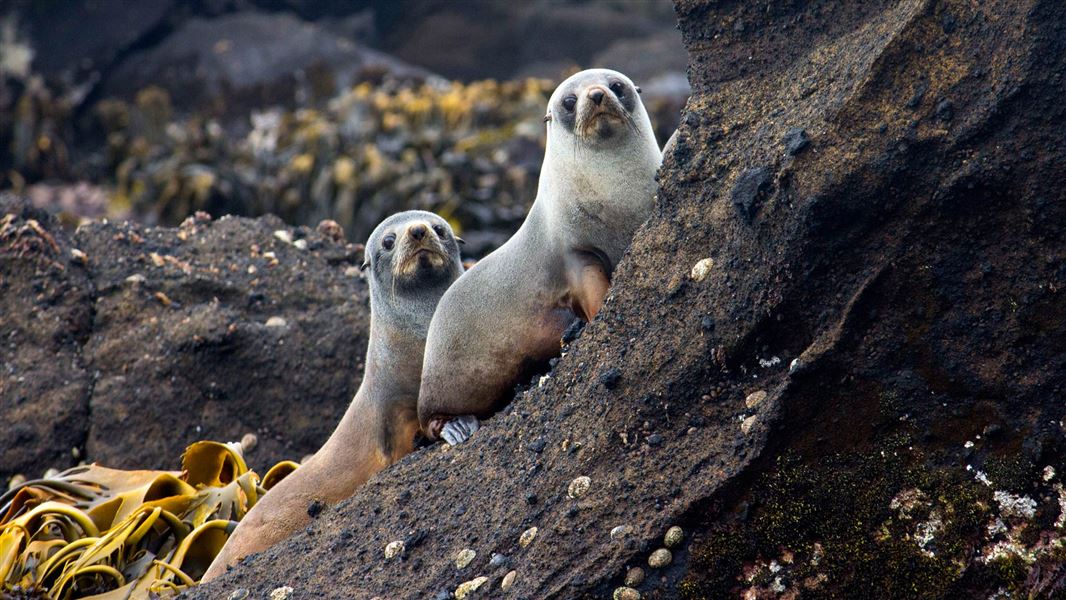Highlights
At the start of the current millennium, the Antipodes were recognised as being the first piece of land to see the new day, although only two scientists got to experience it!
- Mice were confirmed as successfully eradicated from the island in 2018.
- The Antipodes Island/Moutere Mahue Marine Reserve was created in 2014.
- The Antipodes Island Castaway Depot meant the difference between life and death for those shipwrecked on this lonely island in the treacherous Southern Ocean.
Geography
View a map of the Antipodes Islands.
The volcanic islands of the Antipodes Island group lie 860 km to the southeast of New Zealand's Stewart Island/Rakiura.
The group consists of the main Antipodes Island (around 2000 ha), Bollons Island to the north (52 ha), and several other smaller islets and rocks.
The highest point on the islands is Mount Galloway (366 m), which is also the group's most recently active volcano, although an exact eruption date is unknown.
Birds
The islands are home to a wide variety of sea and land bird species including the endemic Antipodes snipe and pipit and two species of parakeet including the Antipodes, or unicolor, parakeet. This bird is notable for, among other things, its habit of eating meat – both scavenging seabird carcasses and even hunting the small grey-backed storm petrel.
The seabirds range from the tiny storm petrel to the Antipodean wandering albatross, one of the largest flying birds in the world. Small populations of white-capped and black-browed mollymawks breed on Bollons Island. There are also erect-crested and rock hopper penguins and nine species of burrowing petrel.
Plants
The Antipodes Islands are mostly covered by tussock lands interspersed with patches of tall, prickly shield fern and megaherbs in the wetter areas.
Low herbs and shorter grasses can be seen particularly where seabirds have opened up areas. Recovering slip scars are covered by distinctive and fragile white lichens.
Of the 71 species of plants present on the island only three are introduced species.
The lack of browsing mammals contributes to a lush vegetation with natural communities being in excellent condition.
Archeology
In 2016 DOC carried out the Million Dollar Mouse Project to eradicate mice from the islands, followed in 2018 by a monitoring programme to determine how successful this had been.
In 2018 the opportunity was taken to also carry out archaeological survey of the main Antipodes Island, including detailed recording of the 1886 castaway depot hut, the south coast sealers’ camp, the South Bay castaway cave, and five fingerposts. The south coast campsite is one of the earliest intact European sealing sites in New Zealand, which alone makes it highly significant.
The results of the survey illustrate the efforts that people made to survive in this harsh and unforgiving environment and also demonstrate how our relationship with the islands has changed over time, from a place of unbridled exploitation 200 years ago to having the highest level of legal protection for natureal values today.
A report was commissioned by DOC to document the archaeology of the islands, based on work carried out to date by various scientists and researchers and the results of an archaeological survey in 2018.
Download the report: Archaeology of the Antipodes Islands 2023 (PDF, 13,320K) By Peter Petchey, Rowley Taylor, Kath Walker and Graeme Elliott
History
The Antipodes Islands were discovered in 1800 and named "Penantipodes" by their discoverer, Captain Waterhouse of H.M.S. Reliance, because of its situation near the antipodes of London (i.e. a line drawn directly through the earth from London comes out very close to the Antipodes Islands). Over time the name has been shortened to "Antipodes".
Sealing
1804 saw the first sealing gang arrive at the Antipodes. This American gang killed about 60,000 seals over the course of the year they were stationed on the islands. While the location of prime sealing grounds was jealously guarded at the time, the evidence they took home led to a sealing boom on the islands.
After 1807 sealing was occasional and catches small. By the 1830s seals were all but wiped out and sealing in the Antipodes came to an end.
Shipwrecks
There have been three shipwrecks at the Antipodes: Spirit of Dawn, President Felix Feliue and Totorore. The Totorore is the most recent shipwreck in subantarctic New Zealand. The 10 m yacht was wrecked in 1999 while supporting an albatross research programme. Two lives were lost.
The Antipodes Island Castaway Depot was built for shipwreck victims in 1886.
